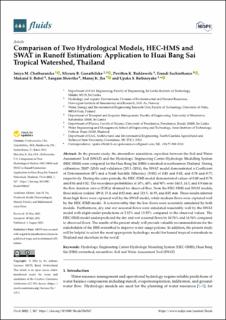| dc.contributor.author | Chathuranika, Imiya M. | |
| dc.contributor.author | Gunathilake, Miyuru | |
| dc.contributor.author | Baddewela, Pavithra K. | |
| dc.contributor.author | Sachinthanie, Erandi | |
| dc.contributor.author | Babel, Mukand S. | |
| dc.contributor.author | Shrestha, Sangam | |
| dc.contributor.author | Jha, Manoj K. | |
| dc.contributor.author | Rathnayake, Upaka S. | |
| dc.date.accessioned | 2022-10-26T07:10:43Z | |
| dc.date.available | 2022-10-26T07:10:43Z | |
| dc.date.created | 2022-09-23T09:43:01Z | |
| dc.date.issued | 2022-08-04 | |
| dc.identifier.citation | Fluids. 2022, 7 (8), 1-14. | en_US |
| dc.identifier.issn | 2311-5521 | |
| dc.identifier.uri | https://hdl.handle.net/11250/3028294 | |
| dc.description.abstract | In the present study, the streamflow simulation capacities between the Soil and Water Assessment Tool (SWAT) and the Hydrologic Engineering Centre-Hydrologic Modelling System (HEC-HMS) were compared for the Huai Bang Sai (HBS) watershed in northeastern Thailand. During calibration (2007–2010) and validation (2011–2014), the SWAT model demonstrated a Coefficient of Determination (R2) and a Nash Sutcliffe Efficiency (NSE) of 0.83 and 0.82, and 0.78 and 0.77, respectively. During the same periods, the HEC-HMS model demonstrated values of 0.80 and 0.79, and 0.84 and 0.82. The exceedance probabilities at 10%, 40%, and 90% were 144.5, 14.5, and 0.9 mm in the flow duration curves (FDCs) obtained for observed flow. From the HEC-HMS and SWAT models, these indices yielded 109.0, 15.0, and 0.02 mm, and 123.5, 16.95, and 0.02 mm. These results inferred those high flows were captured well by the SWAT model, while medium flows were captured well by the HEC-HMS model. It is noteworthy that the low flows were accurately simulated by both models. Furthermore, dry and wet seasonal flows were simulated reasonably well by the SWAT model with slight under-predictions of 2.12% and 13.52% compared to the observed values. The HEC-HMS model under-predicted the dry and wet seasonal flows by 10.76% and 18.54% compared to observed flows. The results of the present study will provide valuable recommendations for the stakeholders of the HBS watershed to improve water usage policies. In addition, the present study will be helpful to select the most appropriate hydrologic model for humid tropical watersheds in Thailand and elsewhere in the world. | en_US |
| dc.description.abstract | Comparison of Two Hydrological Models, HEC-HMS and SWAT in Runoff Estimation: Application to Huai Bang Sai Tropical Watershed, Thailand | en_US |
| dc.language.iso | eng | en_US |
| dc.publisher | MDPI | en_US |
| dc.rights | Navngivelse 4.0 Internasjonal | * |
| dc.rights.uri | http://creativecommons.org/licenses/by/4.0/deed.no | * |
| dc.title | Comparison of Two Hydrological Models, HEC-HMS and SWAT in Runoff Estimation: Application to Huai Bang Sai Tropical Watershed, Thailand | en_US |
| dc.title.alternative | Comparison of Two Hydrological Models, HEC-HMS and SWAT in Runoff Estimation: Application to Huai Bang Sai Tropical Watershed, Thailand | en_US |
| dc.type | Peer reviewed | en_US |
| dc.type | Journal article | en_US |
| dc.description.version | publishedVersion | en_US |
| dc.rights.holder | © 2022 by the authors | en_US |
| dc.source.pagenumber | 1-14 | en_US |
| dc.source.volume | 7 | en_US |
| dc.source.journal | Fluids | en_US |
| dc.source.issue | 8 | en_US |
| dc.identifier.doi | 10.3390/fluids7080267 | |
| dc.identifier.cristin | 2054637 | |
| dc.source.articlenumber | 267 | en_US |
| cristin.ispublished | true | |
| cristin.fulltext | original | |
| cristin.qualitycode | 1 | |

